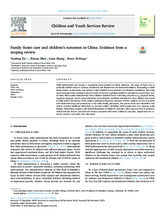Displaying 601 - 610 of 2214
This study used a scoping review method to map the scope of research regarding children’s outcomes in current foster care in China.
Theoretically informed by intersectionality, queer, and feminist theories, the purpose of this community based qualitative research study was to gain a nuanced understanding of the experiences of 25 diverse LGBTQ former foster youth before, during, and after being in foster care.
The authors of this study investigated incidence of secondary traumatic stress (STS) and psychological predictors relevant to secondary and primary stress appraisal in UK foster carers.
The purpose of this study was to estimate the costs of hospitalization for physical and mental health conditions by child protection status, including out-of-home-care (OOHC) placement, from birth until 13-years, and to assess the excess costs associated with child protection contact over this period.
For this study, a sample of youth in foster care was used to provide a new examination of the relation between child maltreatment exposure and internalizing symptoms, to test the possible moderating effects of both appraisals and spirituality, and examine differences between children and adolescents.
A number of psychological factors have been found to be relevant in terms of problematic use of digital devices. Some of them may serve as risk factors, while others mean protection. The main goal of present study was to determine user profiles and to examine differences among them based on several psychological variables using cluster analysis.
This study used a dataset of 1426 young adults experiencing homelessness (YAEH) from 7 different US cities to examine the historical risk and resilience characteristics of those involved in foster care alone, juvenile justice alone, both systems (dual status), and no system involvement.
The purpose of this study was to outline prerequisites for interventions aimed at school performance for children in foster care, related to those in normal population studies.
This study examined family- and state child welfare system predictors of successful reunification in the United States, or reunification with no reentries into foster care.
The objective of this study was to examine the utility of child protective services data in identifying predictors of placement disruption.



